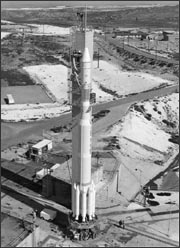
A USGS cartographer who had been cynical about the MSS producing cartographically accurate data with “a little mirror in space,” turned to his colleagues after seeing the first MSS image and said “Gentlemen, that’s a map.” He later wrote a letter to the MSS engineer Virginia Norwood stating “…the MSS is a real mapping instrument.”
Today, 40 years after the first Landsat launch, six Landsat satellites have successfully orbited the Earth supplying a continuous record of Earth’s changing landscape, and the next Landsat satellite is scheduled to launch in Feb. 2013. A poster presentation chronicling some of the Landsat history and imagery is available here (PDF file size = 185 MB).
Further information:
+ NASA’s Earth Observatory: First Landsat image in U.S. archive
+ Looking back at the Landsat 1 launch (video, YouTube)
+ Landsat Looks and Sees
+ Landsat multimedia

Be Part of What’s Next: Emerging Applications of Landsat at AGU24
Anyone making innovative use of Landsat data to meet societal needs today and during coming decades is encouraged to submit and abstract for the upcoming “Emerging Science Applications of Landsat” session at AGU24.





